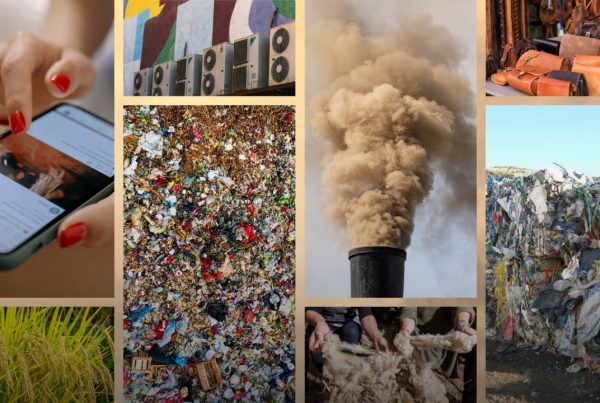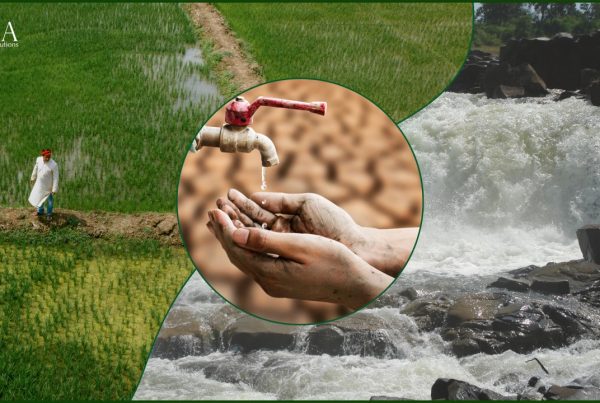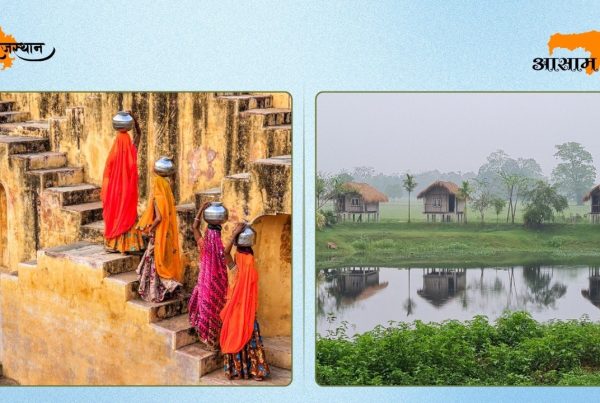The Arctic, Antarctic, and the Hindu-Kush Himalayan Region—Earth’s three poles— serve as powerful climate regulators and vital buffers against the impacts of climate change. These regions act as Earth’s natural air coolers, reflecting solar radiation (albedo effect), storing carbon, and influencing global weather patterns. From controlling the monsoon trends to regulating the ocean currents through thermohaline circulation, the role of these Polar Regions is profound. Yet, they remain undervalued and threatened. Rising temperatures, melting ice, and thawing permafrost are not only altering these landscapes but also affecting the vital functions they perform.
What Polar Ecosystems Offer
Polar ecosystems provide critical ecosystem services including climate regulation, carbon storage, and biodiversity support. The Arctic alone offers services worth about USD 281 billion annually[1]. Permafrost in these regions stores up to 1,700 Gt of carbon, making it a major carbon sink1. Keystone species like krill, vital in the marine food web[2], depend heavily on the extent of summer sea ice in the Antarctic Ocean. These ecosystems also support species such as polar bears, whales, and seabirds, and contribute to global fisheries and oxygen production. Antarctic tourism, commercial fisheries, and regulating services are valued at approximately USD180 billion annually[3].
Meanwhile, the melting of Arctic ice has opened the Northern Sea Route, reducing the shipping path between Europe and Asia by 40%[4], offering economic benefits but necessitating sustainable development. Beyond their economic and ecological value, polar caps also act as time capsules, preserving ancient DNA and microorganisms that offer insights into the past environment[5].
Beyond biodiversity and carbon, Arctic is also a living cultural icescape, supporting over 475,000 Indigenous People (IP) across more than 40 communities including the Inuit, Athabaskans Gwich’ and Aleut in parts of Alaska, Canada, Greenland and Russia, while Sami in the Scandinavian countries[6]. Their Traditional Ecological Knowledge (TEK) holds intangible uniqueness value[7], aligns closely with Nature-based Solutions, and is estimated to deliver up to 37% of the climate mitigation needed by 20308. It has also been shown to enhance ecosystem resilience in Nordic countries[8],[9].
Melting Poles, Rising Stakes
Polar regions are warming disproportionately, making polar sea and land ice important climate indicators. The Arctic is warming nearly four times faster than the global average, a phenomenon known as “Arctic amplification”[10]. As permafrost thaws and Arctic Ocean temperature rises, an estimated 150–250 Gt CO2 equivalent could be released by 2100[11].
The impacts on people and infrastructure are already mounting. By 2050, nearly 70% of Arctic infrastructure—homes, roads, pipelines—is at high risk to permafrost thaw, potentially affecting over 3 million people[12]. In Russia, where 65% of land lies on permafrost, more than 80% of buildings in Vorkuta are showing signs of deformation6. Alaska may incur USD 24.5 billion in damage, Canada USD 23.5 billion and the Qinghai–Tibet Plateau USD 4 billion6. Communities like Kivalina and Shishmaref in Alaska are already planning relocation due to coastal erosion and permafrost melt, with costs in the hundreds of millions[13].
Climate-driven wildfires in Alaska now contribute to 10% of the thermokarst formation[14]. Melting ice also risks releasing of dormant microorganisms annually, some potentially pathogenic[15] as evidenced by the 2016 Siberian anthrax outbreak[16]. With profound effect on polar tourism, the ski season and snowfall are projected to decline16,[17] and the effects are visible in tourist spots[18],[19].
In Antarctica, the potential collapse of Thwaites Glacier (“Doomsday Glacier”)[20] could increase global sea-level by up to 10 feet, threatening coastal communities worldwide. Polar degradation could also have global impacts, including shifts in weather patterns, increasing extreme weather events and altering precipitation patterns. Even the Indian monsoon is vulnerable to this variability, affecting agriculture and water resources across the region[21].
Shared Responsibility and Governance
The Polar Regions represent the classic “tragedy of the commons”, shared global resources with no exclusive ownership, yet increasingly exploited for their untapped natural resources, like fossil fuels and minerals[22]. The melting Central Arctic Ocean is now becoming accessible for unregulated commercial fishing[23].
Addressing these challenges requires international collaboration, through regulatory frameworks, environmental laws, and shared scientific research. There are important governance efforts underway. The Antarctic Treaty System promotes peaceful scientific collaboration and bans military or commercial exploitation[24], while the Madrid Protocol declared Antarctica a natural reserve. The Commission for the Conservation of Antarctic Marine Living Resources has adopted ecosystem-based management, establishing a 1.55 million km² Ross Sea Marine Protected Areas[25].
The Arctic Council, though lacking a single binding treaty, brought attention to Arctic and Indigenous Peoples’ issues at the 2002 World Summit on Sustainable Development[26]. The 2018 Central Arctic Ocean Fisheries Agreement bans unregulated fishing in newly thawing waters for at least 16 years[27]. Over 1,400 Arctic protected areas are co-managed by Indigenous communities using TEK[28]. Tools like ArcNet (mapping 83 marine conservation areas) and Arctic Blue Corridors (tracking migratory species) further support the conservation[29]..
Necessitating Valuation of the “White Capital”
Assigning economic value to the polar ecosystems, the “White Capital”, is a powerful tool in recognising their global benefits in policy and financial decision-making. These ecosystems cover 20% of global land and 16% of oceans, and store immense carbon reserves. However, they remain underrepresented in the SDG framework12.
Of the 16 major climate tipping points, 12 are linked to the poles[30]. Destabilising them could trigger irreversible feedback loops, amplifying global warming, sea-level rise, and extreme weather, that undermine progress on poverty (SDG 1), food security (SDG 2), water access (SDG 6), and biodiversity (SDGs 14 and 15)[31]. Their degradation could consume approximately 40% of the remaining global carbon budget to limit warming under 2°C.
Integrating valuation of ecosystem services such as the carbon storage of Arctic permafrost, the climate regulation of Antarctic ice sheets, and food cycle maintenance by the polar oceans, can highlight the true cost of inaction[32]. Recognising both the tangible and intangible benefits of polar ecosystems could tip the balance toward more sustainable decision-making. With the right policies, partnerships, and perspective, we can ensure these frozen regions continue to support life far beyond their borders.
[1] O’Garra, T. (2017). Economic value of ecosystem services, minerals and oil in a melting Arctic: A preliminary assessment. Ecosystem Services, 24, 180-186. https://doi.org/10.1016/j.ecoser.2017.02.024
[2] Schofield, O., Cimino, M., Doney, S., Friedlaender, A., Meredith, M., Moffat, C., … & Steinberg, D. (2024). Antarctic pelagic ecosystems on a warming planet. Trends in ecology & evolution. https://doi.org/10.1016/j.tree.2024.08.007
[3] Stoeckl, N., Adams, V., Baird, R., Boothroyd, A., Costanza, R., Hatton MacDonald, D., … & Yamazaki, S. (2024). The value of Antarctic and Southern Ocean ecosystem services. Nature Reviews Earth & Environment, 5(3), 153-155. https://doi.org/10.1038/s43017-024-00523-3
[4] Liu H, Mao Z and Zhang Z (2024). From melting ice to green shipping: navigating emission reduction challenges in Arctic shipping in the context of climate change. Front. Environ. Sci. 12:1462623. doi: 10.3389/fenvs.2024.1462623
[5] Harðardóttir, S., Haile, J. S., Ray, J. L., Limoges, A., Van Nieuwenhove, N., Lalande, C., … & Ribeiro, S. (2024). Millennial-scale variations in Arctic sea ice are recorded in sedimentary ancient DNA of the microalga Polarella glacialis. Communications Earth & Environment, 5(1), 25.
[6] Mardikian, L., & Galani, S. (2023). Protecting the Arctic Indigenous peoples’ livelihoods in the face of Climate change: the potential of regional human rights law and the law of the sea. Human Rights Law Review, 23(3), ngad020.
[7] Tagalik, S. (2011). Inuit Qaujimajatuqangit: The role of Indigenous knowledge in supporting wellness in Inuit communities in Nunavut.
[8] Ogar, E., Pecl, G., & Mustonen, T. (2020). Science must embrace traditional and indigenous knowledge to solve our biodiversity crisis. One Earth, 3(2), 162-165.
[9] Palmer, J. (2022). Traditional knowledge guides protection of planetary health in Finland. Mongabay News.
[10] Rantanen, M., Karpechko, A. Y., Lipponen, A., Nordling, K., Hyvärinen, O., Ruosteenoja, K., … & Laaksonen, A. (2022). The Arctic has warmed nearly four times faster than the globe since 1979. Communications earth & environment, 3(1), 168. https://doi.org/10.1038/s43247-022-00498-3
[11] ICCI, 2021. State of the Cryosphere 2021 – A Needed Decade of Urgent Action. International Cryosphere Climate Initiative (ICCI), Stockholm, Sweden. 52 pp.
[12] Hjort , J , Streletskiy , D , Dore , G , Wu , Q , Bjella , K & Luoto , M 2022 , ‘ Impacts of permafrost degradation on infrastructure ‘, Nature Reviews Earth & Environment , vol. 3 , no. 1 , pp. 24-38 . https://doi.org/10.1038/s43017-021-00247-8
[13] Gregg, R. M. (2020). Relocating the Native Village of Shishmaref, Alaska Due to Coastal Erosion [Case study on a project of the Shishmaref Erosion and Relocation Coalition]. Version 2.0. Product of EcoAdapt’s State of Adaptation Program.
[14] Chen, Y., Lara, M. J., Jones, B. M., Frost, G. V., & Hu, F. S. (2021). Thermokarst acceleration in Arctic tundra driven by climate change and fire disturbance. One Earth, 4(12), 1718-1729. 10.1016/j.oneear.2021.11.011
[15] Yarzábal, L. A., Salazar, L. M. B., & Batista-García, R. A. (2021). Climate change, melting cryosphere and frozen pathogens: Should we worry…?. Environmental Sustainability, 4(3), 489-501.
[16] Ezhova, E., Orlov, D., Suhonen, E., Kaverin, D., Mahura, A., Gennadinik, V., … & Kulmala, M. (2021). Climatic factors influencing the anthrax outbreak of 2016 in Siberia, Russia. EcoHealth, 18(2), 217-228.
[17] Shijin, W., Yaqiong, M., Xueyan, Z., & Jia, X. (2020). Polar tourism and environment change: Opportunity, impact and adaptation. Polar Science, 25, 100544.
[18] AFP. (2024, November 28). Santa Claus is worried as there’s no snow in Arctic to celebrate a White Christmas. CNBCTV18. https://www.cnbctv18.com/travel/culture/watch-santa-claus-is-worried-as-theres-no-snow-in-arctic-to-celebrate-a-white-christmas-19516078.htm
[19] Autumn was unusually warm – Finnish Meteorological Institute (2024). Finnish Meteorological Institute. https://en.ilmatieteenlaitos.fi/press-release/3jNwGBZ93krztjIDaHCIRE
[20] Glacier, T. (2024). Widespread seawater intrusions beneath the grounded ice of Thwaites Glacier, Antarctica.
[21] Kulkarni, S., & Agarwal, A. (2025). Arctic sea ice variability and its multiscale association with Indian summer monsoon rainfall at different time scales. Journal of Hydrology, 132729. https://doi.org/10.1016/j.jhydrol.2025.132729
[22] Spence, J., & Hanlon, E. (2025, January 16). ExPLAINer: The geopolitical significance of Greenland. The Belfer Center for Science and International Affairs. https://www.belfercenter.org/research-analysis/explainer-geopolitical-significance-greenland
[23] Climate change, trade and geopolitics – new risks in the Arctic | Swiss Re. (2024, August 5). Climate Change, Trade and Geopolitics – New Risks in the Arctic | Swiss Re. https://www.swissre.com/institute/research/sonar/sonar2023/new-risks-in-arctic.html
[24] The Antarctic Treaty | Antarctic Treaty. (n.d.). https://www.ats.aq/e/antarctictreaty.html
[25] About CCAMLR | CCAMLR. (n.d.). https://www.ccamlr.org/en/organisation
[26] Page, C. P. (2002). Plan of Implementation of the World Summit on Sustainable Development. Sustain. Dev, 24, 20.
[27] Main – Central Arctic Ocean Fisheries Agreement (CAOFA) – Virtual lab. (n.d.). https://vlab.noaa.gov/web/caofa
[28] Actions for Arctic Biodiversity 2013-2021(2015). Implementing the recommendations of the Arctic Biodiversity Assessment. https://oaarchive.arctic-council.org/items/2eaea882-a816-415c-95a8-9a5860fb57cb
[29] ArcNet: protecting marine biodiversity in the Arctic | Projects | WWF. (n.d.). World Wildlife Fund. https://www.worldwildlife.org/projects/arcnet-protecting-marine-biodiversity-in-the-arctic
[30] Armstrong McKay, D. I., Staal, A., Abrams, J. F., Winkelmann, R., Sakschewski, B., Loriani, S., … & Lenton, T. M. (2022). Exceeding 1.5 C global warming could trigger multiple climate tipping points. Science, 377(6611), eabn7950. 10.1126/science.abn7950
[31] Li, X., Guo, H., Cheng, G., Song, X., Ran, Y., Feng, M., … & Cao, B. (2025). Polar regions are critical in achieving global sustainable development goals. Nature Communications, 16(1), 3879. https://doi.org/10.1038/s41467-025-59178-3






